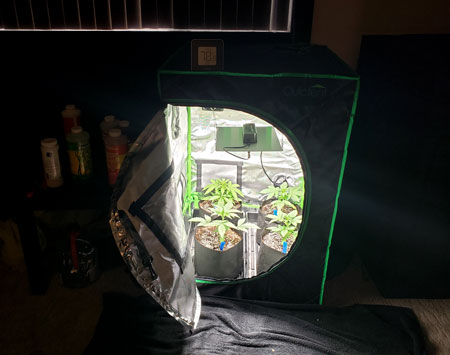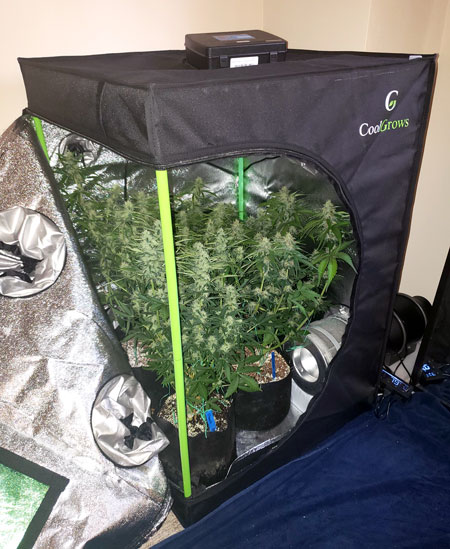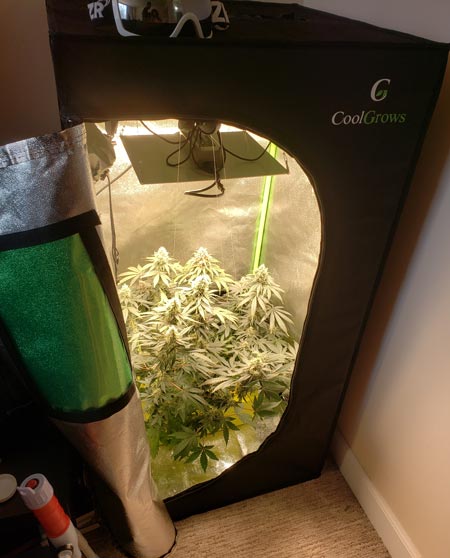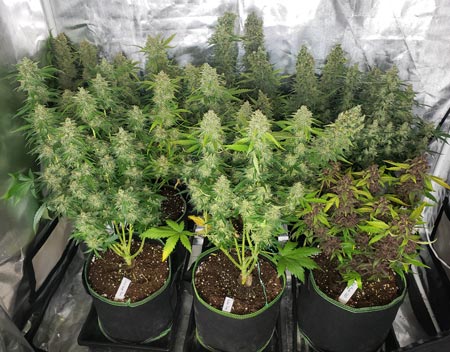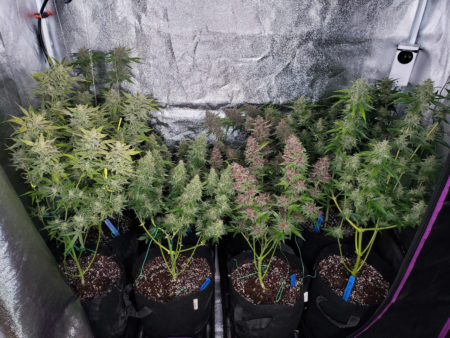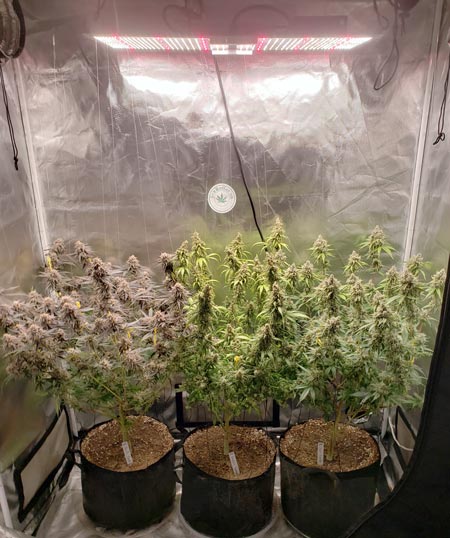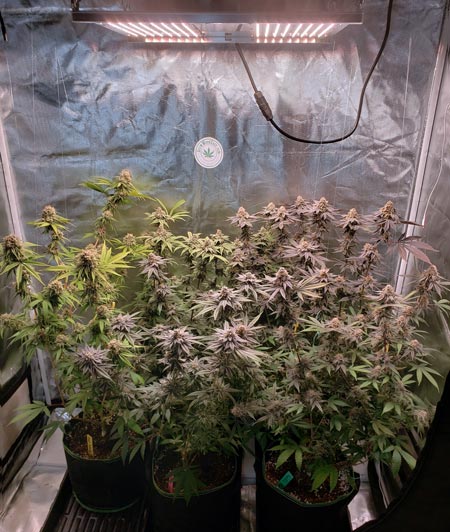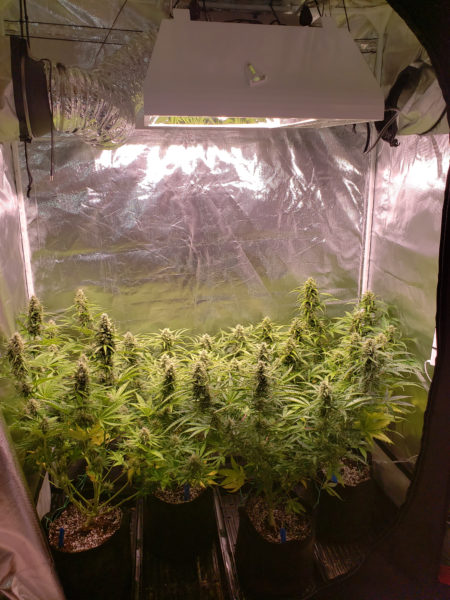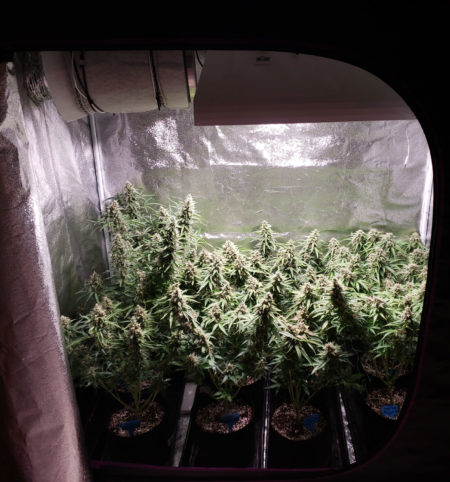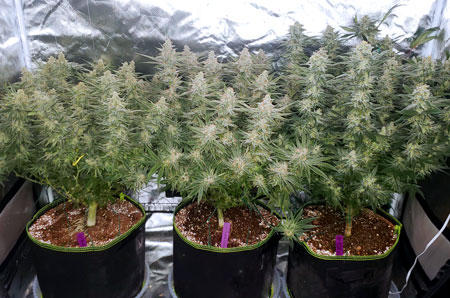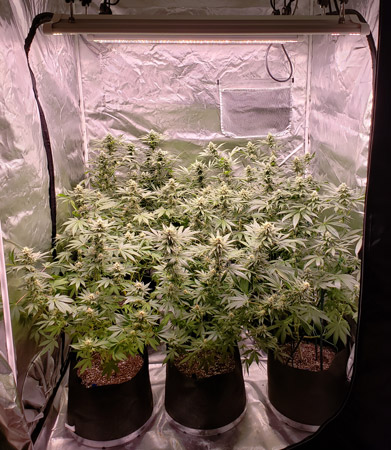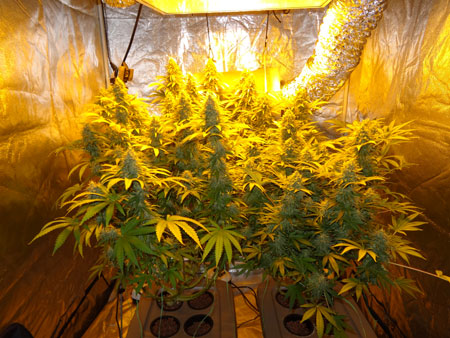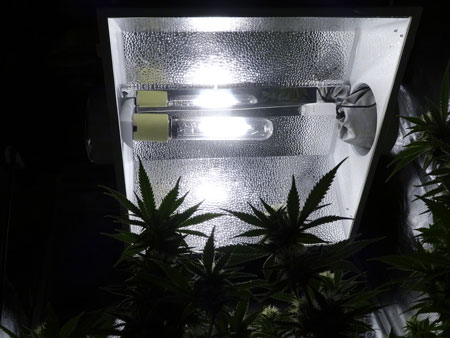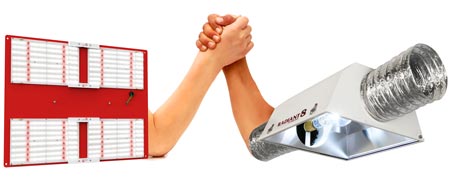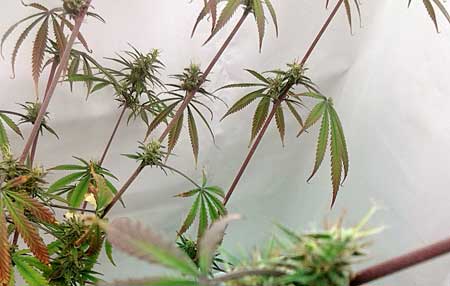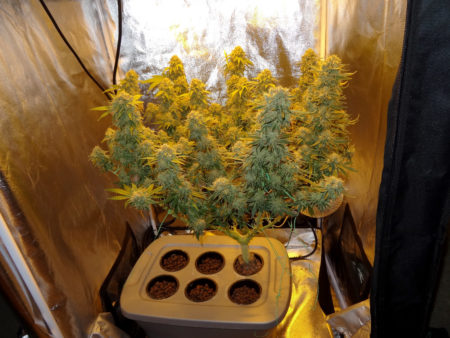by Nebula Haze
Learn exactly what you need to buy to start growing weed indoors. This covers your grow light, grow tent, fan, and smell filtering. You still need to add your grow medium, nutrients (if any), and seeds.
Choose your grow type…
- Bedroom Stealth – $300-400
- 1-4 oz harvest
- Beginner Conquest – $330-600
- 5-10+ oz harvest
- Impress Your Friends – $350-1020
- Up to 1 lb harvest
- 1 lb+ yields – $360-1820
- Harvest 1 lb or more
What to buy to start growing marijuana? Keep reading to find out!
Bedroom Stealth
What you need to get started
- Small grow tent (2’x2’x3′ or 2’x2’x4′) – $70
- LED grow light – HLG 100 (4000k version) – $130
- 4000k/Blue version: shorter plants in the vegetative stage, sparklier buds, but lower yields in flowering stage
- R-spec/Red version: taller plants in the vegetative stage, bigger buds but possibly less sparkle – $130
- Either one works great from seed to harvest, but when I must pick one I personally choose the 4000k version
- 4″ fan and carbon filter – $110
- Alternative: Costs more but more quiet – 4″ Cloudline fan + 4″ ducting + 4″ carbon filter – $160
Total: $310-360
Here’s a list of cannabis strains that stay short.
Pros
- Harvest 1-4 oz every 3-4 months
- Cheap and simple way to learn how to grow cannabis
- Small effective LEDs are easy to buy online
- Low heat, low electricity, and easy to hide
Cons
- Low yields compared to other methods
- Can get a little tricky if height is limited (under 4′). You may have to bend over tall plants and tie them down to keep them shorter. Best to get strains that tend to stay short.
Final Price: $310 (basic) – $360 (quiet fan)
I’ve had great luck with these. Read the full tutorial on setting up and growing cannabis in these mini tents.
You can produce good yields in a small tent if you follow the instructions in my tutorial.
Mini hydroponics (DWC hydro tub)
Beginner Conquest
What you need to get started
- Mid-size grow tent (2’x4’x5′) – $100
- LED grow light – Spider Farmer SF-2000 – $300
- Alternative grow light: 400W MH/HPS Grow Light dimmable to 200W, 300W, or 400W (best for cool grow room) – $120
- 6″ fan and carbon filter – $110
- Alternative: Costs more but more quiet – 6″ Cloudline fan + 6″ ducting + 6″ carbon filter – $200
Total – $330-600
Note: HID (High-Intensity Discharge) grow lights like the 400W MH/HPS are a better choice than LEDs for a cool grow room (regularly under 72°F / 22°C). Cold plants grow slow under LEDs yet thrive under HIDs. A 250W MH/HPS is the perfect size for this tent, but unfortunately, that size is difficult to find these days. However, this particular 400W model is dimmable so you change how much heat and light it produces to dial the light into your environment. Learn more about HID grow lights at the bottom of this article.
Pros
- 5-10+ ounces per harvest
- Grow more plants at once than the previous setup
- Extra height in case plants grow bigger than expected
- Not much heat, sound, or electricity use
Cons
- Not the best choice if you want to grow more than 10 oz per harvest
Final Price: $330 (HPS light) – $600 (LED light + quiet fan)
Example of plants grown under a 250W MH/HPS
This grow tent used a 250W HPS from seed to harvest (did not use a MH bulb in the vegetative stage, which made the plants grow stretchy).
Note: With MH/HPS fixtures, growers generally use a metal halide (MH) bulb in the vegetative stage to keep plants short and bushy, then switch to an HPS bulb for the flowering stage to increase yields and bud density. The above plants were given HPS from seed to harvest, which caused them to stretch taller than if I’d used an MH bulb in the vegetative stage. Still produced excellent yields though!
Spider Farmer SF-2000 in a 2’x4′ grow tent
Impress Your Friends
What you need to get started
- Medium grow tent at least 6′ or 1.8m tall (2’x4’x6′ grow tent is my favorite size; can be tucked into the corner of a room) – $120
- LED grow light – Mars Hydro TSL2000 300W LED grow light – $260
- Alternative grow lights: 400W MH/HPS or 315 LEC/CMH ($120-510) – best for cool grow room because these lights get HOT
- 6″ fan and carbon filter – $110
- Alternative: Costs more but more quiet – 6″ Cloudline fan + 6″ ducting + 6″ carbon filter – $200
Total: $350-1020
Pros
- Harvest up to 1 pound of buds per harvest
- The extra height lets you use stronger grow lights, which majorly pumps up yields
- Easy to tend all plants in this size (no hard-to-reach plants in the back)
- Produces more weed than most growers need for themselves and their friends
Cons
- At 6′ (1.8 m) tall, these grow tents aren’t easy to hide
Final Price: $350 (HPS) – $1020 (best LED + quiet fan)
HLG 300 R-Spec in a 2’x4’x6′ grow tent – produced excellent potency and bud quality, but lower yields than other options in this section
315 LEC/CMH in a 2’x4’x6′ grow tent – hot but powerful (read my full tutorial on how to grow in this exact setup)
Example of a 300W LED grow light in a 2’x4’x6′ grow tent. Check out my grow journal featuring these plants
Those plants in natural light. Giant bud balls.
1 lb+ yields
What you need
- Large grow tent – 4’x4’x6.5′ is excellent for the lights listed here – $120
- LED grow lights – Mars Hydro FC-E4800 LED grow light (480W) – $500
- Alternative grow light: 600W HPS (for cool grow spaces) – high yields, unbelievable bud density, but produces a lot of heat that’s typically vented out a window – $130
- 6″ carbon filter and fan – $110
- The 6″ fan above is powerful and excellent for this setup. However, the 6″ Cloudline “quiet” fan is underpowered for a 4’x4′ tent. If you want a quieter fan in this setup, I recommend upgrading to the 8″ Cloudline fan + 8″ carbon filter + 8″ ducting – $300
Total: $360-$920
Pros
- Grow 1+ lbs of weed or more per harvest
- Grow many plants at once
- Lots of room to spread out
Cons
- You may need to vent heat out a window or use an air conditioner (even LEDs produce significant heat when you’re using a total of 600W)
- Hard to hide because it takes up a lot of room (definitely can’t tuck this into the corner of a bedroom)
Final Price: $360 (HPS) – $1820 (best LED + quiet fan)
LEDs in a 4’x4’x6.5′ grow tent
600W HPS in a 4’x4’x6.5′ grow tent
What Are HID grow lights?
HIDs are big hot bulbs that can burn your skin and are more dangerous to your eyes than LED grow lights. The small sizes don’t produce much heat, but the big ones like 600W and 1000W size produce unbelievable amounts of heat that can raise the temperature of a room to sweltering heights. However, cannabis plants perform extremely well under HIDs when they have good air circulation and reasonable temperatures. Until around 2010, most indoor growers used fluorescent or HID grow lights to grow weed. It’s only been since about 2018-2020 that LEDs have fully overtaken all other grow light types as the most popular cannabis grow light even among many commercial growers.
HID grow lights use a big bulb instead of many smaller diodes like LEDs
Examples of HID grow lights
- MH (Metal Halide) – Gives off a blue-tinted light that keeps cannabis plants short while producing fast healthy growth. Typically used in the vegetative stage. Most MH fixtures can also take an HPS bulb.
- HPS (High-Pressure Sodium) – Produces a garish yellow light that causes vegetative plants to stretch, but encourages flowering plants to produce huge and get remarkably dense potent buds. Most fixtures that can use either MH or HPS bulb. HPS bulbs are typically used in the flowering stage.
- CMH (Ceramic Metal Halide) – Can be used from seed to harvest. Tends to promote stretchy growth. A CMH is sort of halfway between an MH and HPS (Metal Halide technology that uses ceramic like an HPS bulb). Blue CMH bulbs (4000-4200k color) produce extremely high levels of trichomes and above-average terpenes compared to any other grow light, but lower yields than HPS. Bloom CMH bulbs (~3000k color) produce results similar to HPS.
- LEC (Light Emitting Ceramic) – “LEC” is a brand name for a 315W CMH grow light by the company Sun System (LEC is a brand name CMH light). The terms “LEC” and “CMH” are used interchangeably.
HID vs LED Grow Lights: Temperature Matters!
LEDs vs HIDs: Which is better for your grow space?
LED plants hate the cold
LEDs are not suitable for growing plants in the cold because LEDs do not put off much heat or produce enough infrared light to keep plants warm from the inside. In general, plants grow slower and produce smaller buds in cooler temperatures because photosynthesis needs heat. Unlike HIDs which put off significant infrared light, LEDs don’t change the temperature of leaves, so the leaves are essentially always the same temperature as the air. That means with LEDs you want to keep a nice warm environment for the fastest growth and biggest buds.
I’ve found cannabis plants under LEDs seem to perform best when the air temperature is about 80°F / 27°C or a little warmer when the lights are on. No cold nights. Sometimes a small LED doesn’t produce enough heat in a certain environment for fast healthy plant growth. In that case, you may benefit by getting more or bigger LED lights to produce more heat. Or consider an equivalent size HPS.
LEDs Ideal Air Temperature: ~80°F / 27°C
If it gets too cold, cannabis plants under LEDs grow slow and buds don’t thicken up properly.
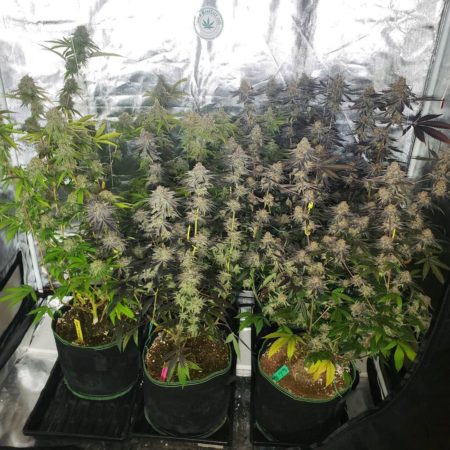
HID plants thrive in cool grow rooms
HID grow lights give off significant amounts of heat, which helps heat up a cool room. On top of that, plants under HIDs tend to be more resistant to the cold in general because the infrared light helps keep their leaves warm from the inside. As a bonus, the tried-and-true MH/HPS combo grow lights are often much cheaper than equivalent LEDs.
The downsides: HID grow lights are a little more dangerous than LEDs because the bulbs get as hot and bright as mini suns. You can’t look at or touch the bulb while it’s running. This isn’t a huge deal but seems kind of industrial in the home environment. Another downside is all HID bulbs need a 5-minute break to cool down after being turned off before the bulb is ready to re-spark and turn on again. That means you can’t quickly flip HID grow lights on and off like with LEDs.
I recommend getting a “dimmable” model, which means you can adjust the brightness levels as needed. Make sure to only adjust the brightness while the light is off (no dimming on the fly like with LEDs).
Companies used to offer more sizes of HIDs, like the mid-sized 250W HPS, but they stopped getting produced once LEDs hit the market. You can still find 150W but if you want something a little bigger I recommend getting a dimmable 400W HPS and adjusting it to your desired brightness/heat level. 400W produces a lot of heat at 100% brightness, but a much more manageable amount of heat when turned down to 50% or 75%. A 315W LEC is also a good mid-size choice.
HID Ideal Air Temperature: 70-85F° (20-30°C)
- Air temperature isn’t the only thing. Light distance is also crucial with HIDs. In order to test the distance, put your hand at plant level when the light is on. If the light feels too hot for you after 30 seconds that means it’s too hot for your plants and the light should be moved further away. HIDs give off infrared light that raises the temperature of leaves (and hands). This means you should test the temperature of both the air and how the light feels on your hands at plant level.
HPS grow lights produce fat, dense buds as long as you control the temperature and make sure the bulb is the right distance away. This manifolded cannabis plant was grown in a 2’x4’x5′ grow tent with a 250W HPS kept about 12″ (30 cm) away and air temperature between 80-85°F (26-30°C).
LECs are another kind of HID grow light.

